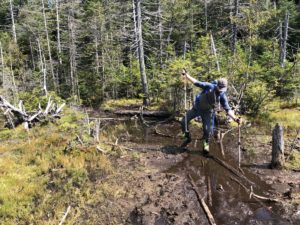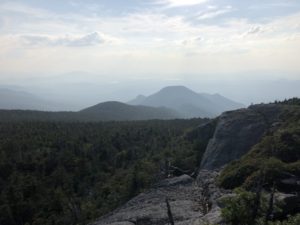Our Need for Nature
I realized as my son and I were hiking in the Adirondacks this last Friday that we spent a week planning, drove 2.5 hours each way, stayed in a cabin for two nights, all to benefit from the (strenuous) 18 hours of hiking in the woods.
And I know that nothing is like hiking for a full day, summiting several high peaks, and challenging yourself to all the beauty the Adirondack State Park has to offer, including mud, rocks, wicked climbs, mud, rock hopping up (or down) streams, butt sliding down scrambles, sun, wind, and, uhm, mud. Not to mention time with amazing people, and time mostly away from movies, music, media, deadlines, reports, advertisements…
 But why is it that we put nature “over there” and don’t have it easily accessible in our own neighborhoods and backyards? Does living in a city have to mean so many hours of driving to get to any wild spaces? If so, we have created an elitist nature because no one without a car can get there. No public transit gets to the ADK High Peaks. And even if a family has a few hours to play together, in between jobs, no one would spend those hours on a bus to go to the middle of nowhere.
But why is it that we put nature “over there” and don’t have it easily accessible in our own neighborhoods and backyards? Does living in a city have to mean so many hours of driving to get to any wild spaces? If so, we have created an elitist nature because no one without a car can get there. No public transit gets to the ADK High Peaks. And even if a family has a few hours to play together, in between jobs, no one would spend those hours on a bus to go to the middle of nowhere.
This is a problem.
Some cities are doing well, by increasing rough and friendly neighborhood parks, increasing access to running routes alongside rivers, and bike paths on old abandoned rail lines. Boston has increased its parkland through the Big Dig Project, making the Rose Fitzgerald Kennedy Greenway, a 1.5 mile long series of Parks. Savannah, Georgia is one city famous for providing green spaces throughout the city, designated from the inception of the city itself in 1733 under the Oglethorpe plan to ensure farming within the city. And there is, of course, New York City, classic for its varied and vibrant Central Park, encompassing 840 acres of everything from ice rinks to boulevards to boat ponds to the fairly woods-like “ramble”. Other access that comes to my mind is the San Antonio River Walk, which is a totally contained and structured access to the river, yet is encourages people to be outdoors. A more recent, beautiful city center change to access nature, and heal it, is the Daylighting of the Sawmill Creek in Yonkers. This effort was messy, costly and of long duration, and now the people of the city are reaping tremendous benefits, with school classes taking field trips for biological and sociological study, with better places to eat outside, with a growth in the downtown economy, and with the improved quality of the water system. Every one of these is of value, and we need more. Yes, these are all designed, and not “wild” in the true sense, but they do grow, change, clean the air, and provide access to wildlife.
We need more messy parks and sculptured parks, parks for skateboards and basketball, and parks for walking along rivers and through woods and gardens. We need more sculpture parks and water parks and play parks for kids. More community gardens, and outdoor venues for eating. We need more visual and tactile connections to growing things, water, sun wind, soil, and activity that is not solely the movement of cars. And we need them all around us, in the city, with no need to own a car or to have extra money to touch our natural world.
The commonality in any and all of these parks, and in our cities themselves, is the fact that they are constantly changing. A town or city, complex with many participants and collaborative, interdependent entities, will change in use, style, and density. Gardens and parks will grow, and rivers will flow. Experiencing these spaces, and their dynamic life, calms us, heals us, and helps us to connect.
Could a need for the energy inherent in the evolution of spaces, places, and systems development be part of what makes us move so often, crave home improvement shows, label phases of our life such as mid-life as “transition”? If we had more accessible, dynamic, and nature-based places, such as the Highline in NYC, or a stream that changes in flow and has natural edges with seasonal blossoms, would we be happier?
We need more access, more diversity, more often.
Get out there, and be greener,
Jodi
1 Like this post (no login required)
